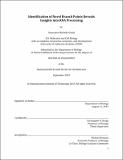Identification of novel branch points reveals insights into RNA processing
Author(s)
Gould, Genevieve Michelle
DownloadFull printable version (8.219Mb)
Other Contributors
Massachusetts Institute of Technology. Department of Biology.
Advisor
Christopher B. Burge.
Terms of use
Metadata
Show full item recordAbstract
Pre-mRNA splicing is a ubiquitous process necessary for the production of functional eukaryotic mRNAs. The branch point (BP) sequence is one of three key nucleotide sequences required for pre-mRNA splicing, however, in metazoa it has been less comprehensively studied than the 5' splice site (5'SS) and 3' splice site (3'SS) due to the relative difficulty of identifying each sequence element. 5'SS and 3'SS are readily identified by aligning spliced cDNAs, ESTs, or RNA-Seq reads to the genome, while lower throughput techniques such as primer extension are usually required to map BPs, with some exceptions. To understand how the BP affects splicing outcomes, we developed an experimental method to locate BPs on a genome-wide scale. Applying our method to Saccharomyces cerevisiae (S. cerevisiae), one of the only eukaryotes for which most BPs are known, allowed us to assess the sensitivity and specificity of our method. We enriched for RNA lariats by isolating RNA from debranching enzyme null yeast and purified circular RNAs (including lariats) from linear RNAs using a 2D PAGE gel. This was followed by a custom library preparation protocol that produced insert ends that identified the BP and 5'SS of individual lariats. Using this method, we located known BPs and discovered a substantial number of novel BPs both in annotated introns and other genomic regions. We attempted to verify these novel introns using RNA-seq and Lariat-seq and surprisingly observed considerable amounts of alternative splicing (AS) in S. cerevisiae beyond the previously known stress-regulated intron retention events and handful of alterative splice sites. Additionally, we observed several introns with 2 BPs and one intron with 3 BPs. In the LSM2 transcript, we showed alternative BP usage was associated with alternative splice site usage, where one of the mRNA isoforms contains a premature termination codon and leads to nonsense-mediated mRNA decay of the transcript. This suggests AS may control gene expression levels in yeast as is known to be the case in metazoans. Preliminary application of our method to Drosophila melanogaster showed recursive splicing, a phenomenon known only to occur in introns larger than 10Kb, to occur in a 383nt intron.
Description
Thesis: Ph. D., Massachusetts Institute of Technology, Department of Biology, 2015. This electronic version was submitted by the student author. The certified thesis is available in the Institute Archives and Special Collections. Cataloged from student-submitted PDF version of thesis. Includes bibliographical references.
Date issued
2015Department
Massachusetts Institute of Technology. Department of BiologyPublisher
Massachusetts Institute of Technology
Keywords
Biology.